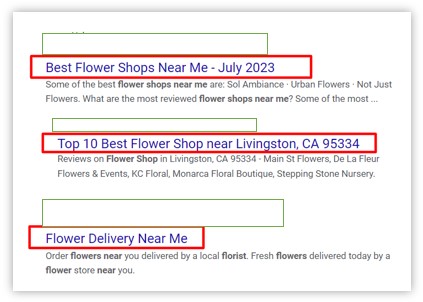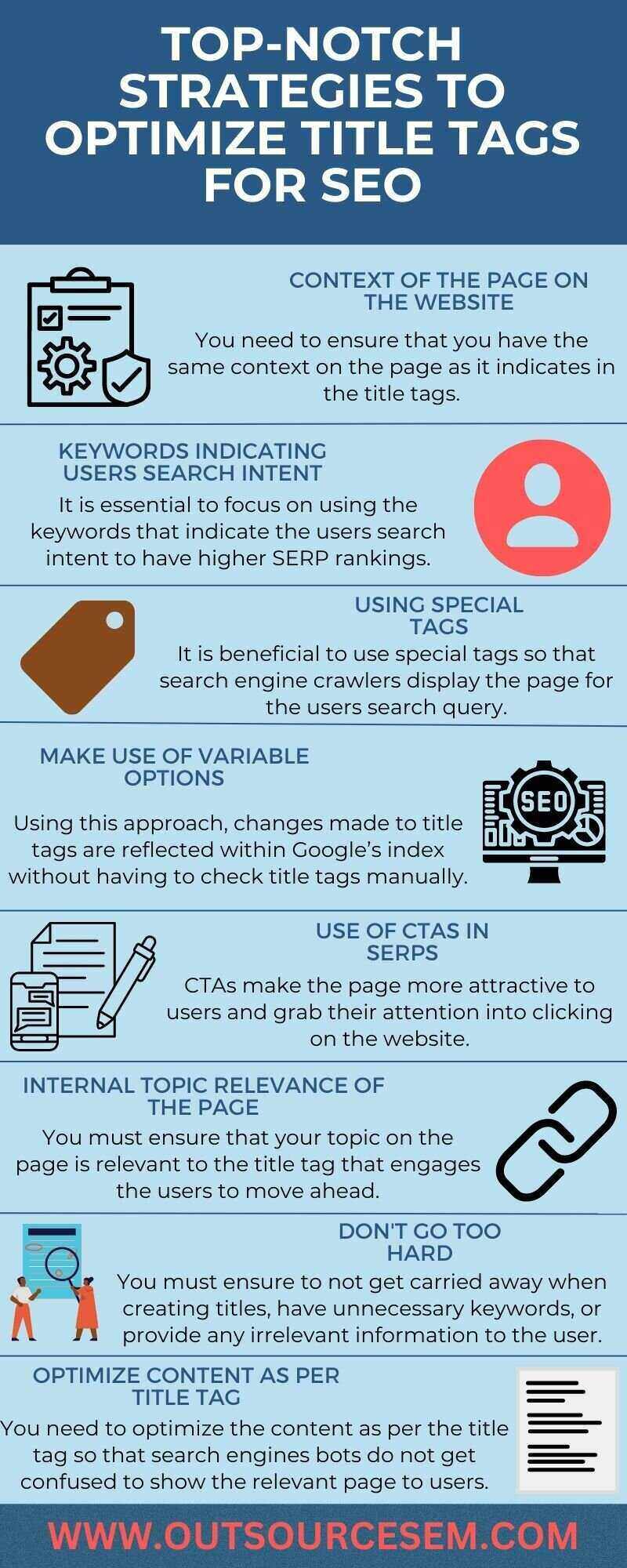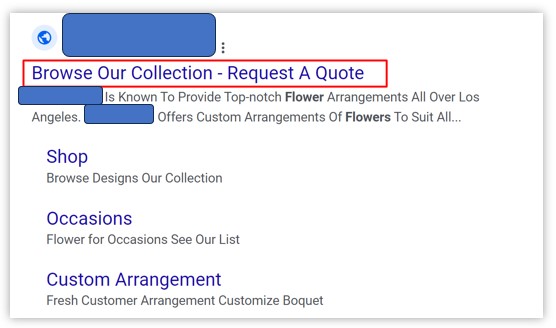As online marketing is different from traditional marketing, you need to work on every minute to improve the website's ranking on the SERPs. To ensure that your SEO plan & strategy yields the desired results, it is important to avoid falling for common SEO myths . While there are several on-page SEO elements that needs to be focused on, one that is often overlooked is title tags. Moz explains that title tags are the second most important thing in SEO after content. Title tags have a massive impact in informing search engines about the page content that helps them show the relevant results for the users' search query . In this blog, we will discuss what title tags are in SEO and how to optimize them for better results.
What are title tags in SEO?
Title tags are essential for search engine optimization (SEO) and play an important role in driving traffic to your website . They are HTML elements found within the ‘head’ tags of a webpage and act as a descriptive title for search engines to understand what the page is about.

When writing title tags, the length should always be kept in mind: a good rule of thumb is to use the primary keyword you want to rank for and keep your title tag between 50-60 characters . Crafting compelling and descriptive titles that include your main keyword will help improve click-through rates from the search engine results pages (SERPs) and help search engines understand the content on the page.
Furthermore, title tags should include supplementary keywords that tie into your primary keyphrase for better organic visibility. Writing and optimizing meta titles and descriptions, optimizing page titles to fit within native search engine character limits, creating meta keywords and employing content marketing are all common tactics to improve your title tags and on page SEO. You can also avail of white label SEO services and hire SEO professionals to craft engaging titles for your video SEO campaigns, local SEO campaigns, enterprise SEO campaigns, etc.
Top-notch strategies to optimize title tags for SEO?

Optimizing title tags for SEO involves crafting meta titles and descriptions that accurately reflect the webpage content, utilizing keywords strategically, adhering to a set SEO title length, and including pertinent meta keywords. Utilizing a meta title checker can also assist in optimizing page titles for the best results. Here are eight crucial factors to take into account while making your title tags search-friendly
1. Context of the page on the site
The page’s context within the site is important for optimizing title tags for search as it allows search engines to understand the page's purpose and interpret it accordingly. This can be accomplished by using universal tags across multiple pages and ensuring that the hierarchy within the website is properly structured to allow clear navigation. For example, a site will be labeled with descriptive tags and categories that distinguish each page, allowing search engines to understand better the page's context and how it relates to a user’s search query. In addition, contextual inbound links from other pages can help search engines better understand the relevancy of the content, thus driving more organic searches.
The purpose of a page also plays a role in optimizing title tags for search. For instance, a blog post should have a different tag compared to an informational page. Additionally, optimizing the title tag for the targeted primary keyword should be the top priority when creating a new page. Having an effective title tag is beneficial as it is the first thing potential visitors see when they search for a specific topic, and it can help draw readers' interest. Furthermore, including other relevant keywords within the title can allow for more specific searches to be made, bringing more people to the page as a result.
Ultimately, as a site grows and evolves, the page’s context within the site should be considered when optimizing title tags for search. This will allow online visitors to more easily find the content they are looking for, and for search engines to better define the page's purpose. Additionally, this will assist in allowing a website to have greater visibility overall, as it will be able to rank higher and adapt to the changing landscape of SEO.
2. Keywords indicating users search intent
User search intent keyword is key to effective SEO optimization on page title tags. The aim is to use the keywords that most accurately describe the page content in terms of what a searcher wants and needs when looking for a keyword. This is a two-step process: first, the words targeted should be as specific as they can be and related to the searcher’s needs; and second, the title tags on a page should be crafted in such a way as to make the page appear higher in the search engine results pages (SERPs).

A higher click-through rate (CTR) from the SERPs will be achieved by implementing a searcher intent keyword use strategy. This is important both for SEO ranking and user experience – higher CTR equals a higher number of visitors coming to the website. To get the most from searcher intent keyword use, it is important to have an accurate meta title and description and a good optimization plan for meta tags & page titles. It is also critical to use a meta title checker and SEO title length guidance to ensure the titles are properly optimized for SEO. You can avail white label SEO audit services and have SEO keyword research done for your page to determine which keywords are the best in your SEO strategy when writing title tags.
By accurately describing the page content using targeted keywords and optimizing titles for SEO , websites can achieve a higher ranking and more visitors. With proper implementation of searcher intent keyword use, website owners can increase their page visibility and see a return on their SEO efforts. With the help of white label SEO services or outsourcing SEO services, you can avail of content marketing services so that content specialists write the best title tags for your web page.
3. Using special tags
Unique tags are an important element in achieving successful SEO. Title tags are the clickable heading that appears on the SERPs for each website page. They provide search engine users with a brief overview of the page content and are a key factor in determining how a page will rank in the search engine results. Including keywords in the title tags can optimize your website more effectively, improving visibility and page rankings.
Meta titles are the most important meta tags in SEO; they provide the shortest description of the page’s content. The goal of meta title tags is to give users information to encourage them to click the link and view your page. Marketers typically make their title tags as short as possible while still using relevant keywords and ensuring they accurately reflect the content.
It is also important to keep the SEO title length in mind when optimizing titles. SEO title length is usually kept between 40-60 characters, although some search engines may have different limits. By keeping the length under Google’s recommended limit, you will be able to fit the most important information. You can use SEO tools like meta title checker to check your title length before publishing your web page.
On-page SEO involves improving page titles, meta descriptions, page URLs and more to make them search engine-friendly. Content marketing can go hand in hand with on-page SEO to help promote the website even further. The content that marketers produce needs to be of the highest quality to attract users to the website and also have targeted keywords to help optimize the website.
Unique tags are a vital element of successful SEO. By combining targeted and relevant keywords with on page SEO tactics, website owners can optimize their website to achieve higher page rankings and better visibility in the search engine results. In addition, you can also employ white label SEO services. White label SEO is a service that allows website owners to outsource SEO work to other agencies without disclosing that they are not the original creator of the content. This can give website owners more flexibility and allow their SEO campaign to be handled by experienced SEO professionals.
4. Make use of variable options
Dynamic options refer to updating your webpage's title tags and other relevant elements in real time. Using dynamic options when optimizing your title tags for SEO helps save time and ensures all page elements are properly indexed. Using this approach, the changes made to the title tags are reflected within Google’s index without having to check the tags manually. This allows for faster, more accurate titles to be generated, as a single change will be immediately applied.
Another advantage of dynamic options is the addition of metadata to your page. Another critical factor when optimizing for SEO is proper tagging. Meta titles are the pages' titles in the SERP (‘search engine results page’). Meta descriptions provide a brief summary of what the page is about. These elements should set the frame and guide prospects and customers to the landing page. Lastly, meta keywords also affect search engine crawlers as they index the page in terms of relevance and subject matter. These elements will be effectively managed by using dynamic options when optimizing for SEO.
5. Use of CTAs in SERPs
Call to action (CTAs) in search engine result pages (SERPs) can greatly help optimize title tags for SEO. CTAs can entice users and give them a reason to click on a link, such as subscribing to a blog, signing up for a service, or joining a newsletter. Additionally, CTAs can be optimized for SEO to ensure they are visible in SERPs by ensuring proper meta title and page title length, implementing meta keywords, and optimizing the meta description.

Call to action makes the page more attractive to users and grab their attention into clicking on the website. Furthermore, the use of CTAs will help users to understand further the purpose and content of the page, as well as help boost the website's on-page SEO. Furthermore, meta title checker and SEO title length tools can be used to ensure that the CTA’s are properly optimized for SERP success. Ultimately, a well-crafted and optimized CTA has the potential to drastically improve page SEO by making it more visible to both users and search engines.
6. Internal topic relevance of the page
When optimizing your title tags for SEO, it is important to consider topical relevance within the page. Utilizing keywords related to the page's content makes it easier for search engines to categorize and rank the page. This is extremely important for driving organic traffic to your page. Moreover, using certain keyword phrases within the meta title and description can help your page reach higher search engine results. A meta title checker can help you verify that your title tags are properly optimized for SEO. Additionally, keeping your page title within SEO-friendly length can help search engines index your page more easily. White label SEO services can help you get the best on-page SEO results, as SEO professionals have mastery in optimizing the essential SEO metrics to enhance the performance of SEO campaigns.
Furthermore, content marketing should be considered a crucial part of any SEO strategy, as high-quality content is one of the best ways to rank higher on the search engine result page naturally. Finally, meta keywords should not be overlooked when optimizing title tags for SEO as this provides another opportunity to signal to search engines what your page is about.
7. Don't go too hard
The phrase “Don’t Go Too Hard” is especially important when it comes to optimizing title tags for search engine optimization (SEO). When creating meta titles, page titles and SEO titles for your website, it is of great importance to ensure that your titles are accurate, informative and concise. Too often, site owners will get carried away when creating titles, resulting in titles that may be too long, have unnecessary keywords, or don’t provide any meaningful information to the user. Overly-long titles also take up precious space in search engine results pages (SERPs), meaning users may be less likely to click on your link.
Additionally, when optimizing your titles for SEO, it is important to make sure that the text is not keyword stuffed. Using too many keywords in your title can lead to penalties from Google, as well as decreased user engagement. Incorporating the brand’s name into the title can also be beneficial, as this helps boost brand reputation and awareness. Furthermore, it is important to ensure that the titles are different for each page - this prevents pages from competing for the same keywords and competing for SERPs. Overall, when creating titles for SEO, it is important to ensure they are accurate, informative and concise.
8. Optimize content as per title tag
Title tags are one of the most important elements for any SEO strategy as they greatly impact how the website and its pages appear in search engine results. The title tag is the first element of any page that a search engine looks at while displaying pages in SERP(search engine result page). It helps both Google and the users to identify what the page is about, and hence it should be descriptive of what is present on the page.
A good, relevant, well-crafted title tag can work wonders for your SEO strategy and on-page optimization. Properly optimizing title tags for SEO with keywords can make them more visible on search engines and help increase your organic search ranking. Title tags should be optimized with page-specific keywords to ensure they are well-indexed and ranked for the most relevant search terms. Title tag length should also be considered while optimizing, as search engines truncate the length of a title tag and it should be of a certain size to provide the best visibility.
Apart from the content, title tags and meta description should be optimized with white label SEO techniques and content marketing. Effectively-written meta tags will allow the content to stand out and impact the SERPs more. Also keyword research should also be done with relevant keywords associated with the target page to make sure maximum rankings are achieved.
Title tags greatly impact SEO, so their optimization should not be overlooked. You can attain a higher ranking in SERPs with proper research, content, SEO and white label solutions. Therefore, keeping the title tag’s importance in perspective should be a priority for anyone who wants to succeed in SEO and web page optimization.
How important is HTML title tag in SEO?
The HTML title tag serves two vital purposes: to provide visitors with an initial indication of the page content they are looking at and to communicate the page title to search engine spiders.
A title tag is an HTML element that specifies the title of a web page. Generally, it is specified in the head section of an HTML document. However, it can also be placed in the body. The title tag is usually placed at the top of the page before other elements, making it one of the first things a user sees after reaching the landing page.
When writing a title tag, it is also important to remember the length limit. While title tags can technically include up to 75 characters, it is generally recommended to stick to between 50-60 characters to guarantee that it won’t be truncated in the search engine results. (Exceeding the character limit means that part of the title will be cut off, making it less effective in terms of SEO value and convincing users to click on the link).
Overall, title tags are a vital component of SEO and essential for driving website traffic. A great title tag should accurately describe the content of a page while also including key terms that can help search engine spiders identify the page. It should be kept within the character limit, as exceeding it can result in the title being cut off in the search engine results. Creating an effective title tag is an important investment for any business with an online presence.
How can we understand title tags in HTML code with the help of an example?
A title tag is an important element of any HTML page. It is placed in the head element at the top of the page and should be used to describe a webpage concisely and relevantly. It is one of the most important aspects of SEO (search engine optimization) and should be carefully crafted to maximize its effectiveness.
The most basic version of a title tag consists of the page's title, followed by the website's or brand's name. This simple version is easy to read and understand. For example, a title tag for a blog post on a business website might look like:
"Online Shopping Trends - Amazon Inc."
However, adding more information to a title tag can have an even bigger impact. A well-crafted title tag will use relevant keywords describing the topic and additional information about the website or brand. This can result in more clicks and visits to the page from search results. For example, the same blog post from Amazon Inc could have a more effective title tag that looks something like this:
"2020 eCommerce Trends - Shop and Learn from Amazon Inc."
Using keywords such as “2020” and “e-commerce” will help search engines match the page more accurately with relevant searches and increase the page's visibility. Including the brand name - Amazon Inc, in the title tag can also help visitors recognize the page and thus gain trust that they will find what they are looking for.
In terms of the HTML code, the title tag should be placed within the tags of a webpage, like:

Title tags should be carefully crafted to help increase the visibility and relevance of a webpage. This involves using relevant keywords in the title and including pertinent information about the website or brand. The title tag is placed within the head tags of the page, with the title wrapped in title tags. Doing so will ensure that search engines can accurately index the page for relevant keyword searches.
Bottom line
Title tags are essential for successful SEO, contributing to high search engine rankings. To optimize them, keep them under 60 characters, include your primary keyword near the beginning of the title, include meta tags, meta keywords, and use natural language for readability. Outsourcing and white label SEO services provide expert assistance in content marketing and on-page SEO to help boost search engine rankings. With proper title tag optimization, you can gain more visitors to your website and increase conversions. As you outsource PPC services for PPC audit, lead generation, campaign analysis, etc., similarly, you can outsource SEO services for SEO audit, SEO report, SEO analytics, link building,competition analysis, etc., so that the SEO professionals help improve your website ranking on SERPs. By contacting our digital marketing experts you can avail various other SEO services like appliance repair SEO, plumbing SEO, painting SEO, lawyer SEO, electrician SEO for home service business according to the needs and preferences.
References:
• What Is a title tag?
• Title tag optimization: a complete how-to guide
